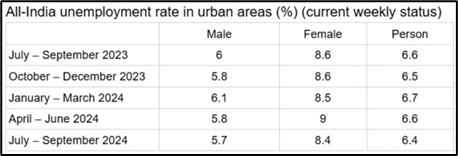What’s in Today’s Article?
- About Unemployment
- Measuring Unemployment (Methods, NSSO, CMIE, Challenges, Govt. Initiatives, etc.)
- News Summary
What is Unemployment?
- Unemployment occurs when individuals who are capable of working, actively seeking work, and willing to work at prevailing wages are unable to find jobs.
- It is an important indicator of the economic health of a country, reflecting the level of economic activity, productivity, and social well-being.
Measuring Unemployment in India:
- Government of India employs various methods and surveys to measure unemployment.
- Key agencies responsible for unemployment data collection and analysis include the Ministry of Statistics and Programme Implementation (MoSPI), National Sample Survey Office (NSSO), and the Centre for Monitoring Indian Economy (CMIE).
National Sample Survey Office (NSSO) Surveys:
- It uses two primary measures to classify the working status of individuals:
- Usual Principal and Subsidiary Status (UPSS):
- The UPSS classifies an individual's principal status-whether employed, unemployed, or out of the labor force-based on the activity they spent the most time on in the previous year.
- An individual who works in a subsidiary role for at least 30 days within the year is also counted as employed under this measure.
- Current Weekly Status (CWS):
- The CWS method adopts a shorter reference period of one week.
- An individual is counted as employed if they worked for at least one hour on any day during the seven days preceding the survey date.
- As a result, unemployment rates under CWS are typically higher than those measured by UPSS, as the probability of finding work over a week is lower compared to an entire year.
**Note: NSSO merged with Central Statistics Office (CSO) to form the National Statistical Office (NSO) in May, 2019.
Centre for Monitoring Indian Economy (CMIE):
- The CMIE is an independent private limited entity that serves both as an economic think-tank as well as a business information company.
- CMIE provides high-frequency data on unemployment through its Consumer Pyramids Household Survey (CPHS).
- This data is updated regularly and offers insights into unemployment trends on a monthly basis.
Key Unemployment Indicators Used in India:
- Unemployment Rate (UR): The percentage of the labor force that is unemployed and actively seeking employment.
- Labor Force Participation Rate (LFPR): The percentage of the working-age population that is either employed or actively seeking employment.
- Worker Population Ratio (WPR): The proportion of the working-age population that is employed.
Challenges in Measuring Unemployment in India:
- Informal Sector Dominance: A large portion of India’s workforce is employed in the informal sector, making it difficult to capture accurate employment data.
- Underemployment and Disguised Unemployment: Many employed individuals work below their skill levels or in low-productivity jobs, masking the true extent of unemployment.
- Data Frequency and Timeliness: There is often a lag in data collection and reporting, making it challenging to get a real-time picture of unemployment.
Government Initiatives to Tackle Unemployment:
- The Indian government has launched several initiatives to reduce unemployment, including:
- Skill India Mission: Aims to provide skills training to millions of young Indians, aligning their skills with industry needs.
- Make in India: Focuses on boosting manufacturing to create more jobs.
- Atmanirbhar Bharat: Aims to enhance domestic production and employment.
- Startup India: Encourages entrepreneurship and innovation to generate new employment opportunities.
News Summary:
- The National Statistical Office (NSO) reported a decline in the quarterly unemployment rate for urban areas to a record low of 6.4% in the July-September 2024 period, down from 6.6% in the previous quarter and the same period last year.
- This marks the lowest unemployment rate since the Periodic Labour Force Survey (PLFS) began in April-June 2018.

- Key Highlights:
- Labour Market Indicators:
- Labour Force Participation Rate (LFPR): Rose to a record high of 50.4%, reflecting an increase in people actively working or seeking work.
- Worker Population Ratio (WPR): Reached a record-high level of 47.2%, indicating more people are employed.
- Gender-Specific Data:
- Female Unemployment: Dropped to a record low of 8.4%, but remained above 8% for the fifth consecutive quarter.
- Male Unemployment: Declined to 5.7%, compared to 5.8% in the previous quarter and 6% a year ago.
- Improvement in Employment Types:
- Regular wage/salaried workers increased to 23.1%, up from 22% a year ago.
- Self-employed workers, including own-account workers and employers, rose to 15.3% from 14.4% last year, though slightly lower than the previous quarter's 15.4%.
- Economic Activity:
- Experts attribute the improved indicators to increased economic activity and hiring by micro, small, and medium enterprises (MSMEs).










